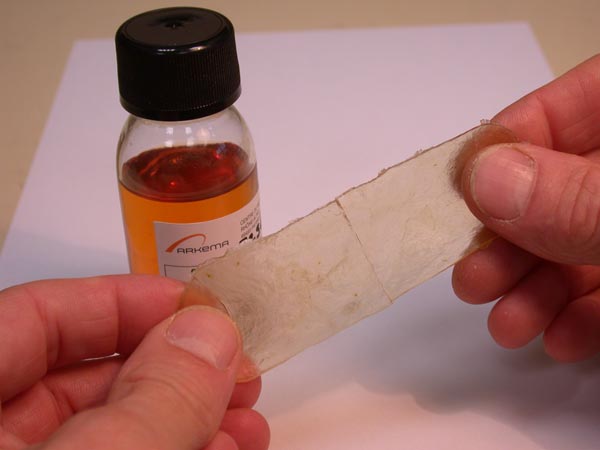Electroactive Polymers
Electroactive Polymers, or EAPs, are polymers that exhibit a change in size or shape when stimulated by an electric field. The most common applications of this type of material are in actuators and sensors. A typical characteristic property of an EAP is that they will undergo a large amount of deformation while sustaining large forces.
The majority of historic actuators are made of ceramic piezoelectric materials. While these materials are able to withstand large forces, they commonly will only deform a fraction of a percent. In the late 1990s, it has been demonstrated that some EAPs can exhibit up to a 380% strain, which is much more than any ceramic actuator. Another one of the most common applications for EAPs is in the field of robotics in the development of artificial muscles. Due to this being one of the most common and attractive applications, EAPs are often referred to as artificial muscles.
The field of EAPs emerged back in 1880, when Wilhelm Roentgen designed an experiment in which he tested the effect of an electrical current on the mechanical properties of a rubber band. The rubber band was fixed at one end and was attached to a mass at the other. It was then charged and discharged to study the change in length with electrical current. M.P. Sacerdote followed up on Roentgen’s experiment by formulating a theory on strain response to an applied electric field in 1899. It wasn’t until the year 1925 that the first piezoelectric polymer was discovered (Electret). Electret was formed by combining carnauba wax, rosin and beeswax, and then cooling the solution while it is subject to an applied DC electrical bias. The mixture would then solidify into a polymeric material that exhibited a piezoelectric effect.
Electroactive Polymers
Polymers that respond to environmental conditions other than an applied electrical current have also been a large part of this area of study. In 1949, Katchalsky et al. demonstrated that when collagen filaments are dipped in acid or alkali solutions they would respond with a change in volume. The collagen filaments were found to expand in an acidic solution and contract in an alkali solution. Although other stimuli (such as pH) have been investigated, due to its ease and practicality most research has been devoted to developing polymers that respond to electrical stimuli in order to mimic biological systems.
It wasn’t until the late 1960s when the next major breakthrough in EAPs was observed. In 1969, Kawai was able to demonstrate that polyvinylidene fluoride (PVDF) exhibits a large piezoelectric effect. This sparked research interest in developing other polymers systems that would show a similar effect. In 1977, the first electrically conducting polymers were discovered by Hideki Shirakawa et al. Shirakawa along with Alan MacDiarmid and Alan Heeger demonstrated that polyacetylene was electrically conductive, and that by doping it with iodine vapor, they could enhance its conductivity by 8 orders of magnitude. Thus the conductance was close to that of a metal. By the late 1980s a number of other polymers had been shown to exhibit a piezoelectric effect or were demonstrated to be conductive.
EAP materials can be easily manufactured into various shapes due to the ease in processing many polymeric materials, making them very versatile materials. One potential application for EAPs is that they can potentially be integrated into microelectromechanical systems (MEMS) to produce smart actuators. As the most prospective practical research direction, EAPs have been utilized in artificial muscles. Their ability to emulate the operation of biological muscles with high fracture toughness, large actuation strain and inherent vibration damping draw the attention of scientists in this field.
In recent years, “electro active polymers for refreshable Braille displays” has emerged to aid the visually impaired in fast reading and computer assisted communication. This concept is based on using an EAP actuator configured in an array form. Rows of electrodes on one side of an EAP film and columns on the other activate individual elements in the array. Each element is mounted with a Braille dot and is lowered by applying a voltage across the thickness of the selected element, causing local thickness reduction. Under computer control, dots would be activated to create tactile patterns of highs and lows representing the information to be read.
Small pumps can also be achieved by applying EAP materials. These pumps could be used for drug delivery, microfluidic devices, active flow control, and a multitude of consumer applications. The most likely configuration for a pump based on actuators would be a dual diaphragm device. The advantages that an ionomeric pump could offer would be low voltage (battery) operation, extremely low noise signature, high system efficiency, and highly accurate control of flow rate.
Another technology that can benefit from the unique properties of EAP actuators is optical membranes. Due to their low modulus, the mechanical impedance of the actuators, they are well-matched to common optical membrane materials. Also, a single EAP actuator is capable of generating displacements that range from micrometers to centimeters. For this reason, these materials can be used for static shape correction and jitter suppression. These actuators could also be used to correct for optical aberrations due to atmospheric interference.
Since these materials exhibit excellent electroactive character, EAP materials show potential in biomimetic-robot research, stress sensors and acoustics field, which will make EAPs become a more attractive study topic in the near future. They have been used for various actuators such as face muscles and arm muscles in humanoid robots.
You might also like
| Polymer Matrix Composites What is Polymer Matrix Composite ? Polymer... | Smart Materials : Dielectric Elastomers What is Dielectric Elastomers ? Dielectric... | Smart Materials : Self-Healing Materials What is Self-Healing Material? Self-healing... | Types of Materials Metals Metals are elements that generally... |



 Alloy Suppliers
Alloy Suppliers
 Aluminum
Aluminum
 Aluminum Extrusions
Aluminum Extrusions
 Copper-Brass-Bronze
Copper-Brass-Bronze
 Nickel
Nickel
 Magnets
Magnets
 Stainless Steel
Stainless Steel
 Stainless Steel Tubing
Stainless Steel Tubing
 Steel Service Centers
Steel Service Centers
 Titanium
Titanium
 Tungsten
Tungsten
 Wire Rope
Wire Rope